Impact of Central Bank Independence on Inflation: A Report
VerifiedAdded on 2023/06/10
|118
|25051
|252
Report
AI Summary
This report investigates the effects of central bank independence (CBI) on inflation rates, examining both empirical and theoretical perspectives. It explores the impact of CBI reforms across various countries, with a focus on developing nations in Latin America and Asia, compared to developed countries in North America and Oceania. The study, based on secondary data analysis, delves into the relationship between governments and central banks, analyzing the benefits of CBI reforms and addressing the issue of time inconsistency in monetary policy. The report includes a literature review, research methodology, data analysis through correlation and regression, discussion, and conclusions, providing a comprehensive understanding of how CBI affects inflation. It also identifies geographical variances in the impact of CBI reforms and suggests recommendations for future research.
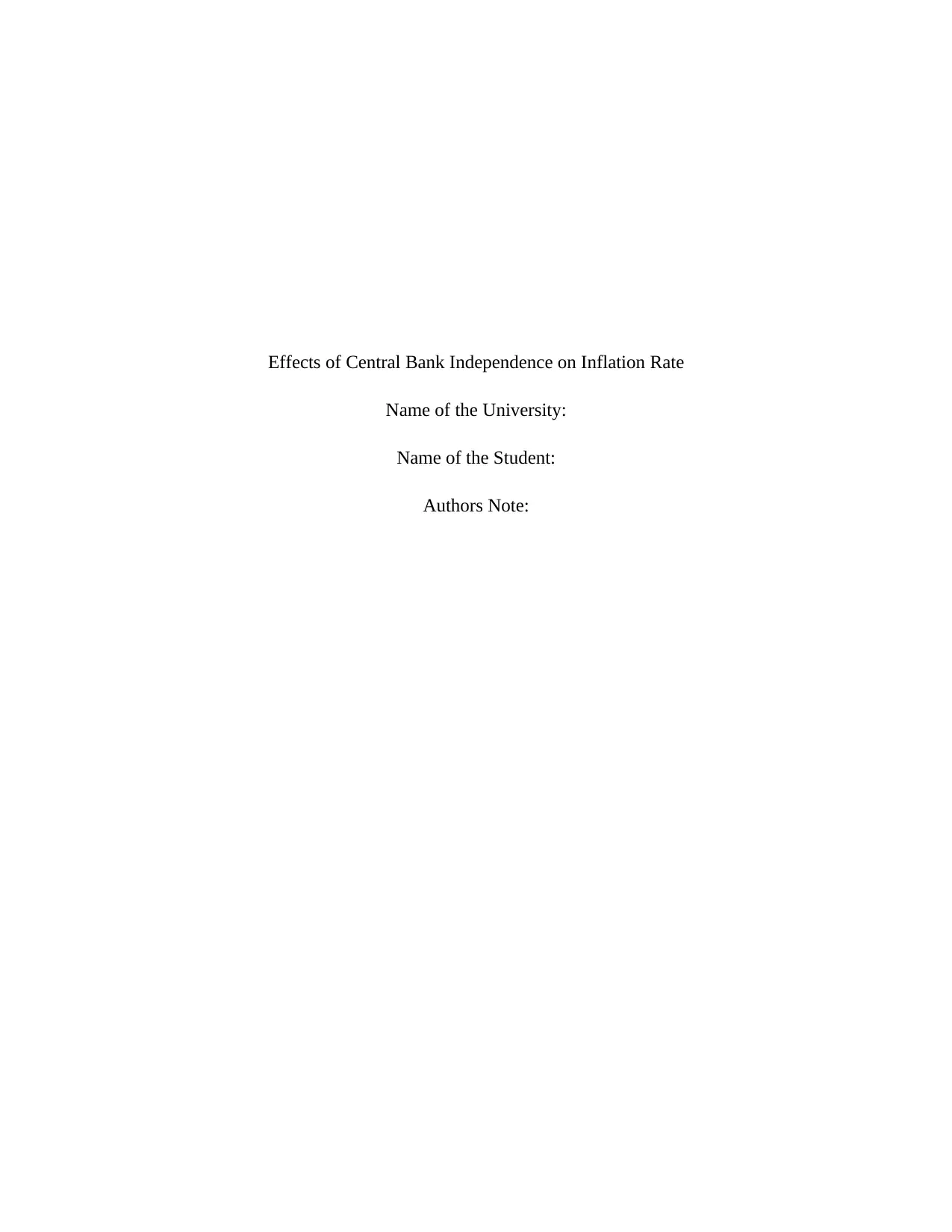
Effects of Central Bank Independence on Inflation Rate
Name of the University:
Name of the Student:
Authors Note:
Name of the University:
Name of the Student:
Authors Note:
Paraphrase This Document
Need a fresh take? Get an instant paraphrase of this document with our AI Paraphraser
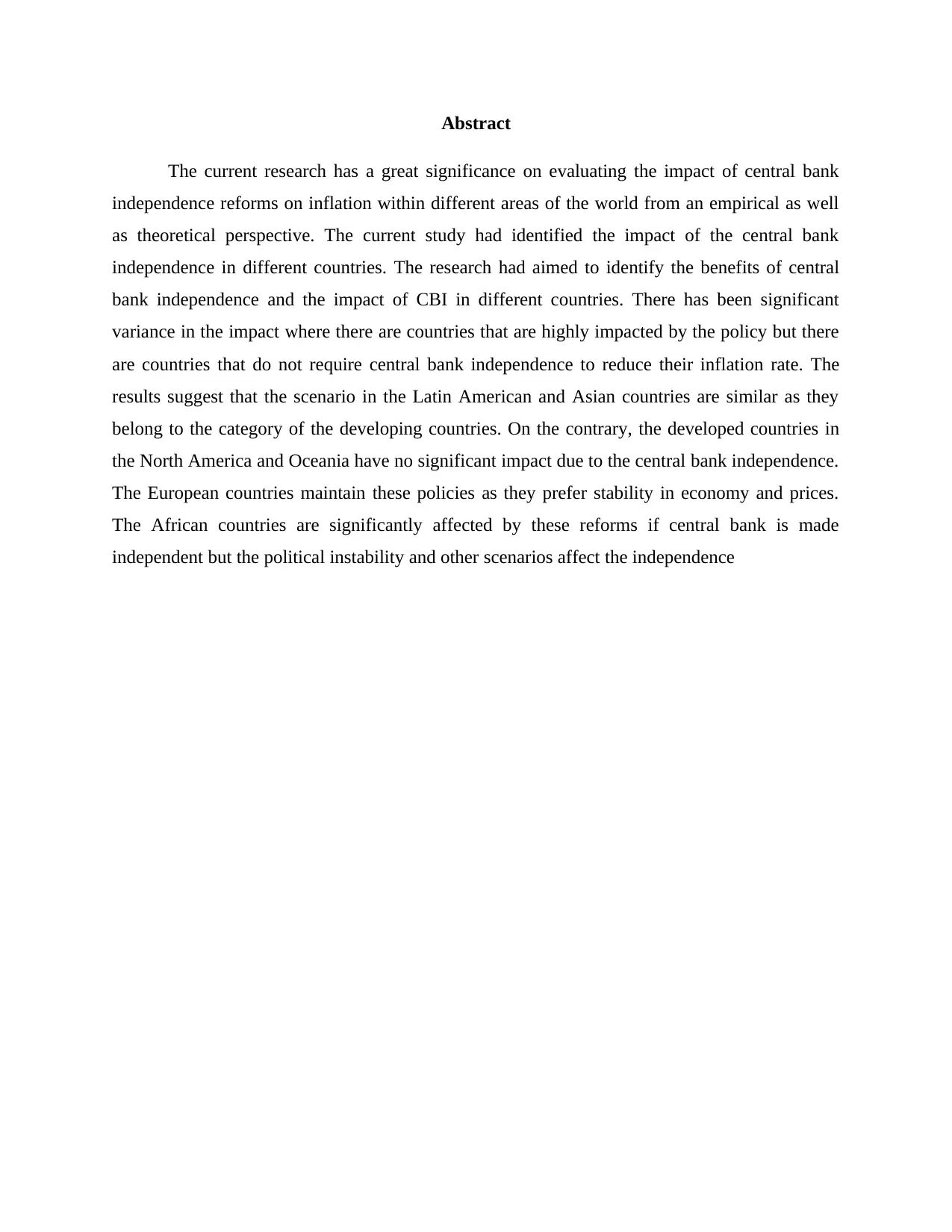
Abstract
The current research has a great significance on evaluating the impact of central bank
independence reforms on inflation within different areas of the world from an empirical as well
as theoretical perspective. The current study had identified the impact of the central bank
independence in different countries. The research had aimed to identify the benefits of central
bank independence and the impact of CBI in different countries. There has been significant
variance in the impact where there are countries that are highly impacted by the policy but there
are countries that do not require central bank independence to reduce their inflation rate. The
results suggest that the scenario in the Latin American and Asian countries are similar as they
belong to the category of the developing countries. On the contrary, the developed countries in
the North America and Oceania have no significant impact due to the central bank independence.
The European countries maintain these policies as they prefer stability in economy and prices.
The African countries are significantly affected by these reforms if central bank is made
independent but the political instability and other scenarios affect the independence
The current research has a great significance on evaluating the impact of central bank
independence reforms on inflation within different areas of the world from an empirical as well
as theoretical perspective. The current study had identified the impact of the central bank
independence in different countries. The research had aimed to identify the benefits of central
bank independence and the impact of CBI in different countries. There has been significant
variance in the impact where there are countries that are highly impacted by the policy but there
are countries that do not require central bank independence to reduce their inflation rate. The
results suggest that the scenario in the Latin American and Asian countries are similar as they
belong to the category of the developing countries. On the contrary, the developed countries in
the North America and Oceania have no significant impact due to the central bank independence.
The European countries maintain these policies as they prefer stability in economy and prices.
The African countries are significantly affected by these reforms if central bank is made
independent but the political instability and other scenarios affect the independence
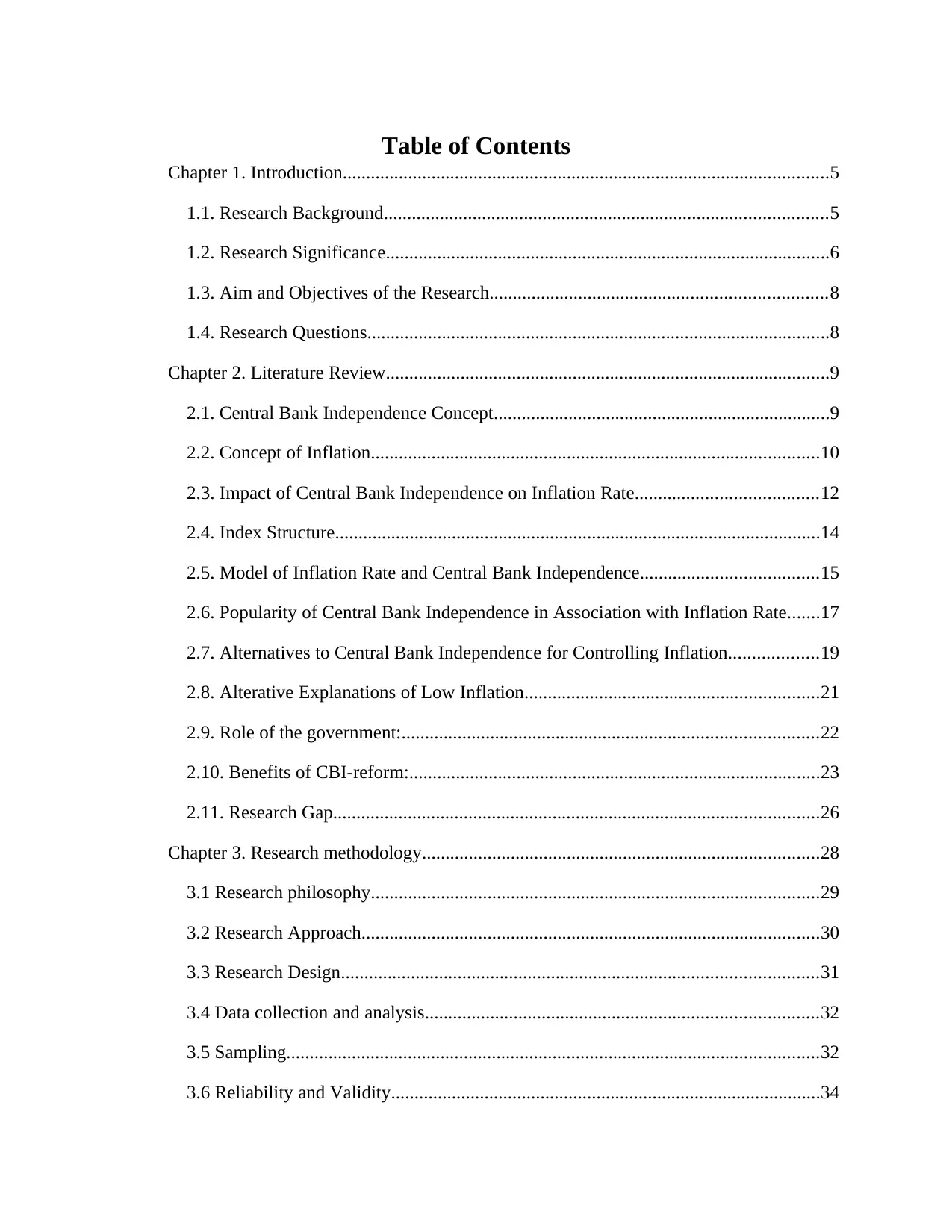
Table of Contents
Chapter 1. Introduction........................................................................................................5
1.1. Research Background...............................................................................................5
1.2. Research Significance...............................................................................................6
1.3. Aim and Objectives of the Research........................................................................8
1.4. Research Questions...................................................................................................8
Chapter 2. Literature Review...............................................................................................9
2.1. Central Bank Independence Concept........................................................................9
2.2. Concept of Inflation................................................................................................10
2.3. Impact of Central Bank Independence on Inflation Rate.......................................12
2.4. Index Structure........................................................................................................14
2.5. Model of Inflation Rate and Central Bank Independence......................................15
2.6. Popularity of Central Bank Independence in Association with Inflation Rate.......17
2.7. Alternatives to Central Bank Independence for Controlling Inflation...................19
2.8. Alterative Explanations of Low Inflation...............................................................21
2.9. Role of the government:.........................................................................................22
2.10. Benefits of CBI-reform:........................................................................................23
2.11. Research Gap........................................................................................................26
Chapter 3. Research methodology.....................................................................................28
3.1 Research philosophy................................................................................................29
3.2 Research Approach..................................................................................................30
3.3 Research Design......................................................................................................31
3.4 Data collection and analysis....................................................................................32
3.5 Sampling..................................................................................................................32
3.6 Reliability and Validity............................................................................................34
Chapter 1. Introduction........................................................................................................5
1.1. Research Background...............................................................................................5
1.2. Research Significance...............................................................................................6
1.3. Aim and Objectives of the Research........................................................................8
1.4. Research Questions...................................................................................................8
Chapter 2. Literature Review...............................................................................................9
2.1. Central Bank Independence Concept........................................................................9
2.2. Concept of Inflation................................................................................................10
2.3. Impact of Central Bank Independence on Inflation Rate.......................................12
2.4. Index Structure........................................................................................................14
2.5. Model of Inflation Rate and Central Bank Independence......................................15
2.6. Popularity of Central Bank Independence in Association with Inflation Rate.......17
2.7. Alternatives to Central Bank Independence for Controlling Inflation...................19
2.8. Alterative Explanations of Low Inflation...............................................................21
2.9. Role of the government:.........................................................................................22
2.10. Benefits of CBI-reform:........................................................................................23
2.11. Research Gap........................................................................................................26
Chapter 3. Research methodology.....................................................................................28
3.1 Research philosophy................................................................................................29
3.2 Research Approach..................................................................................................30
3.3 Research Design......................................................................................................31
3.4 Data collection and analysis....................................................................................32
3.5 Sampling..................................................................................................................32
3.6 Reliability and Validity............................................................................................34
⊘ This is a preview!⊘
Do you want full access?
Subscribe today to unlock all pages.

Trusted by 1+ million students worldwide
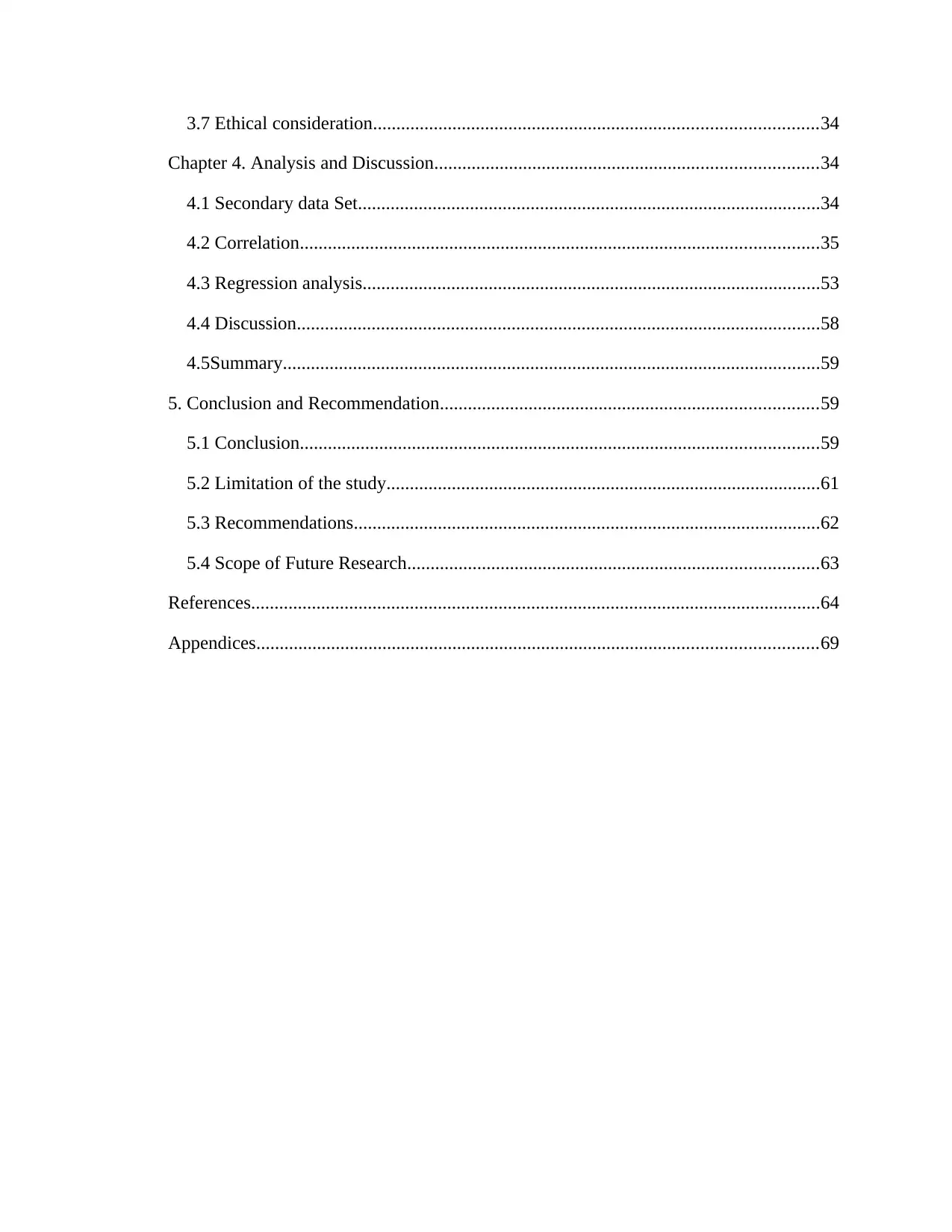
3.7 Ethical consideration...............................................................................................34
Chapter 4. Analysis and Discussion..................................................................................34
4.1 Secondary data Set...................................................................................................34
4.2 Correlation...............................................................................................................35
4.3 Regression analysis..................................................................................................53
4.4 Discussion................................................................................................................58
4.5Summary...................................................................................................................59
5. Conclusion and Recommendation.................................................................................59
5.1 Conclusion...............................................................................................................59
5.2 Limitation of the study.............................................................................................61
5.3 Recommendations....................................................................................................62
5.4 Scope of Future Research........................................................................................63
References..........................................................................................................................64
Appendices........................................................................................................................69
Chapter 4. Analysis and Discussion..................................................................................34
4.1 Secondary data Set...................................................................................................34
4.2 Correlation...............................................................................................................35
4.3 Regression analysis..................................................................................................53
4.4 Discussion................................................................................................................58
4.5Summary...................................................................................................................59
5. Conclusion and Recommendation.................................................................................59
5.1 Conclusion...............................................................................................................59
5.2 Limitation of the study.............................................................................................61
5.3 Recommendations....................................................................................................62
5.4 Scope of Future Research........................................................................................63
References..........................................................................................................................64
Appendices........................................................................................................................69
Paraphrase This Document
Need a fresh take? Get an instant paraphrase of this document with our AI Paraphraser
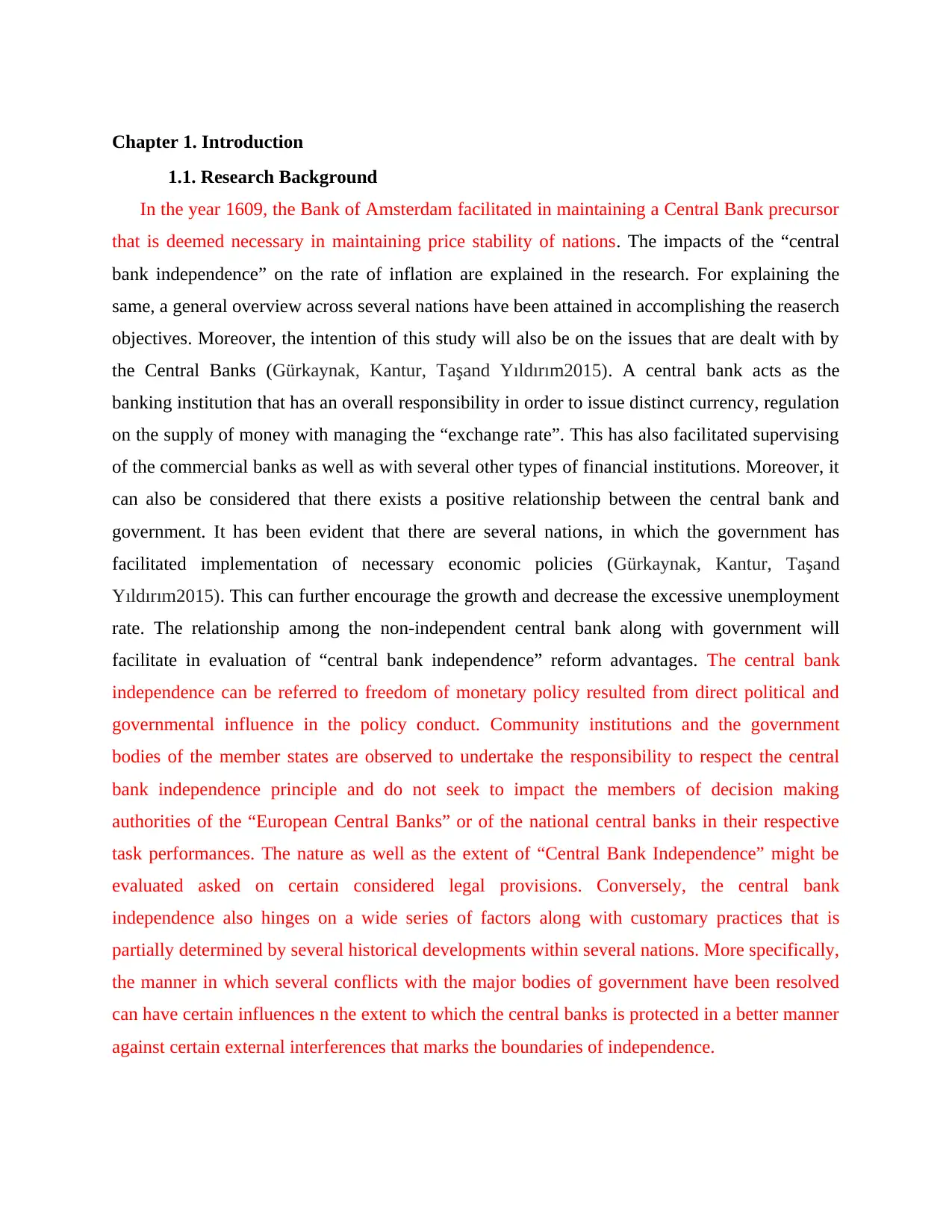
Chapter 1. Introduction
1.1. Research Background
In the year 1609, the Bank of Amsterdam facilitated in maintaining a Central Bank precursor
that is deemed necessary in maintaining price stability of nations. The impacts of the “central
bank independence” on the rate of inflation are explained in the research. For explaining the
same, a general overview across several nations have been attained in accomplishing the reaserch
objectives. Moreover, the intention of this study will also be on the issues that are dealt with by
the Central Banks (Gürkaynak, Kantur, Taşand Yıldırım2015). A central bank acts as the
banking institution that has an overall responsibility in order to issue distinct currency, regulation
on the supply of money with managing the “exchange rate”. This has also facilitated supervising
of the commercial banks as well as with several other types of financial institutions. Moreover, it
can also be considered that there exists a positive relationship between the central bank and
government. It has been evident that there are several nations, in which the government has
facilitated implementation of necessary economic policies (Gürkaynak, Kantur, Taşand
Yıldırım2015). This can further encourage the growth and decrease the excessive unemployment
rate. The relationship among the non-independent central bank along with government will
facilitate in evaluation of “central bank independence” reform advantages. The central bank
independence can be referred to freedom of monetary policy resulted from direct political and
governmental influence in the policy conduct. Community institutions and the government
bodies of the member states are observed to undertake the responsibility to respect the central
bank independence principle and do not seek to impact the members of decision making
authorities of the “European Central Banks” or of the national central banks in their respective
task performances. The nature as well as the extent of “Central Bank Independence” might be
evaluated asked on certain considered legal provisions. Conversely, the central bank
independence also hinges on a wide series of factors along with customary practices that is
partially determined by several historical developments within several nations. More specifically,
the manner in which several conflicts with the major bodies of government have been resolved
can have certain influences n the extent to which the central banks is protected in a better manner
against certain external interferences that marks the boundaries of independence.
1.1. Research Background
In the year 1609, the Bank of Amsterdam facilitated in maintaining a Central Bank precursor
that is deemed necessary in maintaining price stability of nations. The impacts of the “central
bank independence” on the rate of inflation are explained in the research. For explaining the
same, a general overview across several nations have been attained in accomplishing the reaserch
objectives. Moreover, the intention of this study will also be on the issues that are dealt with by
the Central Banks (Gürkaynak, Kantur, Taşand Yıldırım2015). A central bank acts as the
banking institution that has an overall responsibility in order to issue distinct currency, regulation
on the supply of money with managing the “exchange rate”. This has also facilitated supervising
of the commercial banks as well as with several other types of financial institutions. Moreover, it
can also be considered that there exists a positive relationship between the central bank and
government. It has been evident that there are several nations, in which the government has
facilitated implementation of necessary economic policies (Gürkaynak, Kantur, Taşand
Yıldırım2015). This can further encourage the growth and decrease the excessive unemployment
rate. The relationship among the non-independent central bank along with government will
facilitate in evaluation of “central bank independence” reform advantages. The central bank
independence can be referred to freedom of monetary policy resulted from direct political and
governmental influence in the policy conduct. Community institutions and the government
bodies of the member states are observed to undertake the responsibility to respect the central
bank independence principle and do not seek to impact the members of decision making
authorities of the “European Central Banks” or of the national central banks in their respective
task performances. The nature as well as the extent of “Central Bank Independence” might be
evaluated asked on certain considered legal provisions. Conversely, the central bank
independence also hinges on a wide series of factors along with customary practices that is
partially determined by several historical developments within several nations. More specifically,
the manner in which several conflicts with the major bodies of government have been resolved
can have certain influences n the extent to which the central banks is protected in a better manner
against certain external interferences that marks the boundaries of independence.
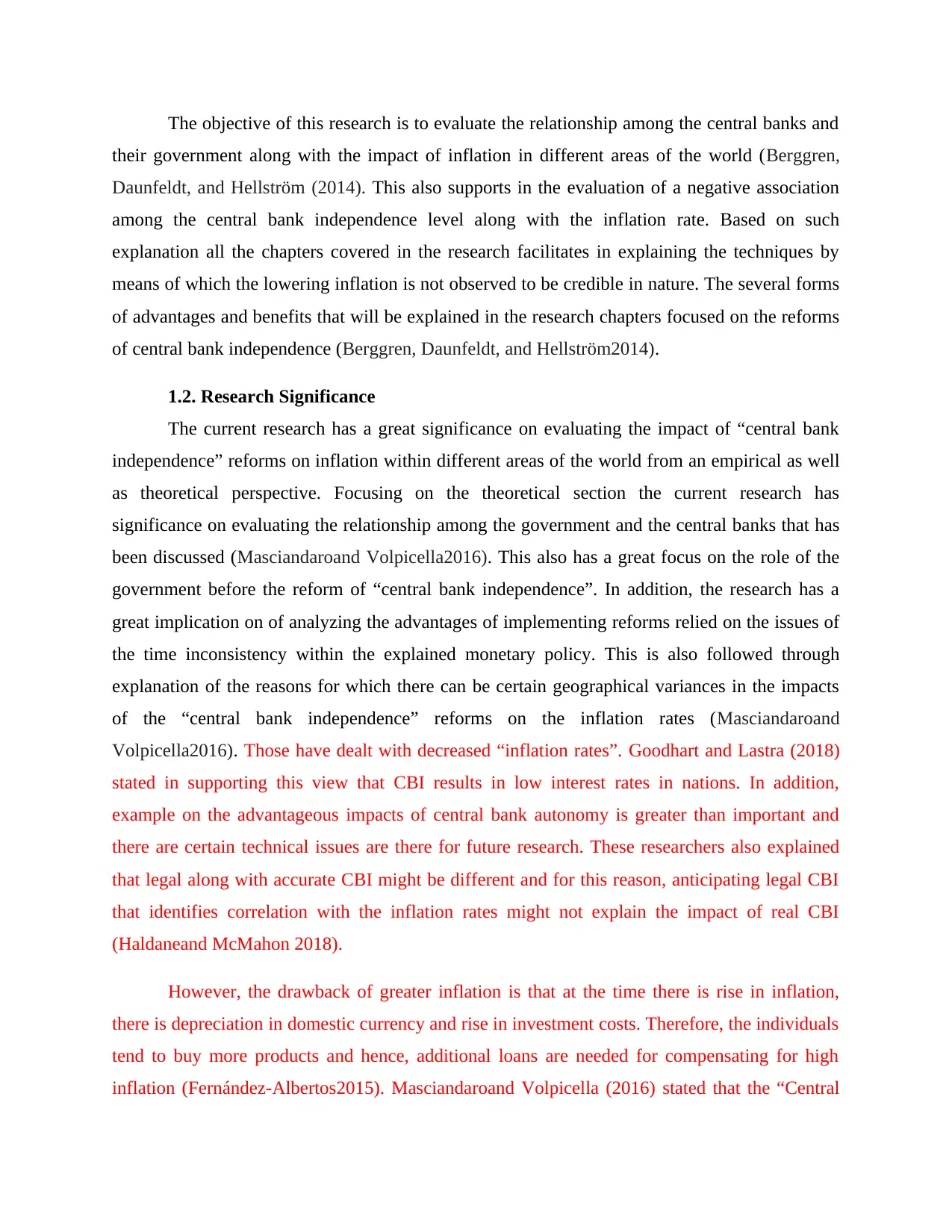
The objective of this research is to evaluate the relationship among the central banks and
their government along with the impact of inflation in different areas of the world (Berggren,
Daunfeldt, and Hellström (2014). This also supports in the evaluation of a negative association
among the central bank independence level along with the inflation rate. Based on such
explanation all the chapters covered in the research facilitates in explaining the techniques by
means of which the lowering inflation is not observed to be credible in nature. The several forms
of advantages and benefits that will be explained in the research chapters focused on the reforms
of central bank independence (Berggren, Daunfeldt, and Hellström2014).
1.2. Research Significance
The current research has a great significance on evaluating the impact of “central bank
independence” reforms on inflation within different areas of the world from an empirical as well
as theoretical perspective. Focusing on the theoretical section the current research has
significance on evaluating the relationship among the government and the central banks that has
been discussed (Masciandaroand Volpicella2016). This also has a great focus on the role of the
government before the reform of “central bank independence”. In addition, the research has a
great implication on of analyzing the advantages of implementing reforms relied on the issues of
the time inconsistency within the explained monetary policy. This is also followed through
explanation of the reasons for which there can be certain geographical variances in the impacts
of the “central bank independence” reforms on the inflation rates (Masciandaroand
Volpicella2016). Those have dealt with decreased “inflation rates”. Goodhart and Lastra (2018)
stated in supporting this view that CBI results in low interest rates in nations. In addition,
example on the advantageous impacts of central bank autonomy is greater than important and
there are certain technical issues are there for future research. These researchers also explained
that legal along with accurate CBI might be different and for this reason, anticipating legal CBI
that identifies correlation with the inflation rates might not explain the impact of real CBI
(Haldaneand McMahon 2018).
However, the drawback of greater inflation is that at the time there is rise in inflation,
there is depreciation in domestic currency and rise in investment costs. Therefore, the individuals
tend to buy more products and hence, additional loans are needed for compensating for high
inflation (Fernández-Albertos2015). Masciandaroand Volpicella (2016) stated that the “Central
their government along with the impact of inflation in different areas of the world (Berggren,
Daunfeldt, and Hellström (2014). This also supports in the evaluation of a negative association
among the central bank independence level along with the inflation rate. Based on such
explanation all the chapters covered in the research facilitates in explaining the techniques by
means of which the lowering inflation is not observed to be credible in nature. The several forms
of advantages and benefits that will be explained in the research chapters focused on the reforms
of central bank independence (Berggren, Daunfeldt, and Hellström2014).
1.2. Research Significance
The current research has a great significance on evaluating the impact of “central bank
independence” reforms on inflation within different areas of the world from an empirical as well
as theoretical perspective. Focusing on the theoretical section the current research has
significance on evaluating the relationship among the government and the central banks that has
been discussed (Masciandaroand Volpicella2016). This also has a great focus on the role of the
government before the reform of “central bank independence”. In addition, the research has a
great implication on of analyzing the advantages of implementing reforms relied on the issues of
the time inconsistency within the explained monetary policy. This is also followed through
explanation of the reasons for which there can be certain geographical variances in the impacts
of the “central bank independence” reforms on the inflation rates (Masciandaroand
Volpicella2016). Those have dealt with decreased “inflation rates”. Goodhart and Lastra (2018)
stated in supporting this view that CBI results in low interest rates in nations. In addition,
example on the advantageous impacts of central bank autonomy is greater than important and
there are certain technical issues are there for future research. These researchers also explained
that legal along with accurate CBI might be different and for this reason, anticipating legal CBI
that identifies correlation with the inflation rates might not explain the impact of real CBI
(Haldaneand McMahon 2018).
However, the drawback of greater inflation is that at the time there is rise in inflation,
there is depreciation in domestic currency and rise in investment costs. Therefore, the individuals
tend to buy more products and hence, additional loans are needed for compensating for high
inflation (Fernández-Albertos2015). Masciandaroand Volpicella (2016) stated that the “Central
⊘ This is a preview!⊘
Do you want full access?
Subscribe today to unlock all pages.

Trusted by 1+ million students worldwide
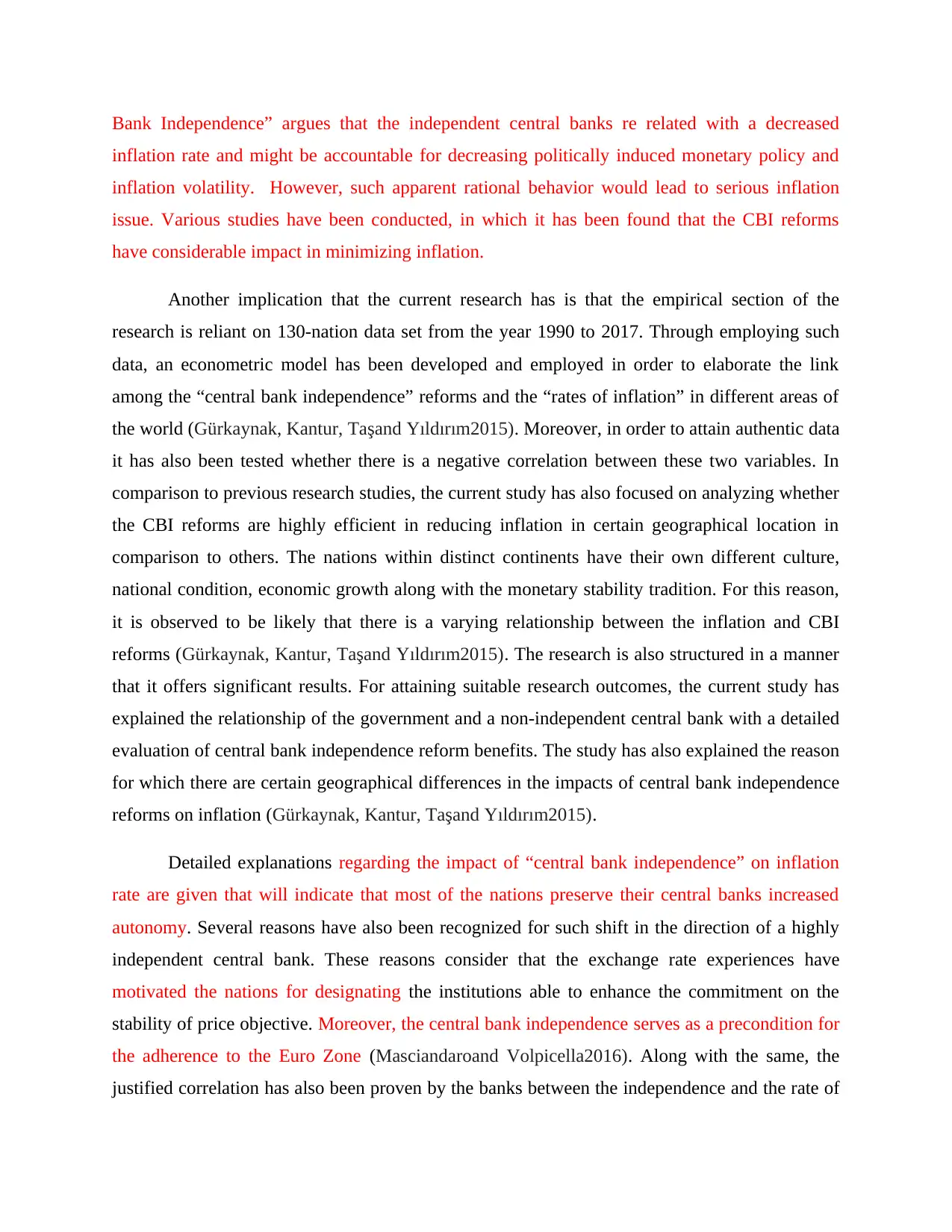
Bank Independence” argues that the independent central banks re related with a decreased
inflation rate and might be accountable for decreasing politically induced monetary policy and
inflation volatility. However, such apparent rational behavior would lead to serious inflation
issue. Various studies have been conducted, in which it has been found that the CBI reforms
have considerable impact in minimizing inflation.
Another implication that the current research has is that the empirical section of the
research is reliant on 130-nation data set from the year 1990 to 2017. Through employing such
data, an econometric model has been developed and employed in order to elaborate the link
among the “central bank independence” reforms and the “rates of inflation” in different areas of
the world (Gürkaynak, Kantur, Taşand Yıldırım2015). Moreover, in order to attain authentic data
it has also been tested whether there is a negative correlation between these two variables. In
comparison to previous research studies, the current study has also focused on analyzing whether
the CBI reforms are highly efficient in reducing inflation in certain geographical location in
comparison to others. The nations within distinct continents have their own different culture,
national condition, economic growth along with the monetary stability tradition. For this reason,
it is observed to be likely that there is a varying relationship between the inflation and CBI
reforms (Gürkaynak, Kantur, Taşand Yıldırım2015). The research is also structured in a manner
that it offers significant results. For attaining suitable research outcomes, the current study has
explained the relationship of the government and a non-independent central bank with a detailed
evaluation of central bank independence reform benefits. The study has also explained the reason
for which there are certain geographical differences in the impacts of central bank independence
reforms on inflation (Gürkaynak, Kantur, Taşand Yıldırım2015).
Detailed explanations regarding the impact of “central bank independence” on inflation
rate are given that will indicate that most of the nations preserve their central banks increased
autonomy. Several reasons have also been recognized for such shift in the direction of a highly
independent central bank. These reasons consider that the exchange rate experiences have
motivated the nations for designating the institutions able to enhance the commitment on the
stability of price objective. Moreover, the central bank independence serves as a precondition for
the adherence to the Euro Zone (Masciandaroand Volpicella2016). Along with the same, the
justified correlation has also been proven by the banks between the independence and the rate of
inflation rate and might be accountable for decreasing politically induced monetary policy and
inflation volatility. However, such apparent rational behavior would lead to serious inflation
issue. Various studies have been conducted, in which it has been found that the CBI reforms
have considerable impact in minimizing inflation.
Another implication that the current research has is that the empirical section of the
research is reliant on 130-nation data set from the year 1990 to 2017. Through employing such
data, an econometric model has been developed and employed in order to elaborate the link
among the “central bank independence” reforms and the “rates of inflation” in different areas of
the world (Gürkaynak, Kantur, Taşand Yıldırım2015). Moreover, in order to attain authentic data
it has also been tested whether there is a negative correlation between these two variables. In
comparison to previous research studies, the current study has also focused on analyzing whether
the CBI reforms are highly efficient in reducing inflation in certain geographical location in
comparison to others. The nations within distinct continents have their own different culture,
national condition, economic growth along with the monetary stability tradition. For this reason,
it is observed to be likely that there is a varying relationship between the inflation and CBI
reforms (Gürkaynak, Kantur, Taşand Yıldırım2015). The research is also structured in a manner
that it offers significant results. For attaining suitable research outcomes, the current study has
explained the relationship of the government and a non-independent central bank with a detailed
evaluation of central bank independence reform benefits. The study has also explained the reason
for which there are certain geographical differences in the impacts of central bank independence
reforms on inflation (Gürkaynak, Kantur, Taşand Yıldırım2015).
Detailed explanations regarding the impact of “central bank independence” on inflation
rate are given that will indicate that most of the nations preserve their central banks increased
autonomy. Several reasons have also been recognized for such shift in the direction of a highly
independent central bank. These reasons consider that the exchange rate experiences have
motivated the nations for designating the institutions able to enhance the commitment on the
stability of price objective. Moreover, the central bank independence serves as a precondition for
the adherence to the Euro Zone (Masciandaroand Volpicella2016). Along with the same, the
justified correlation has also been proven by the banks between the independence and the rate of
Paraphrase This Document
Need a fresh take? Get an instant paraphrase of this document with our AI Paraphraser
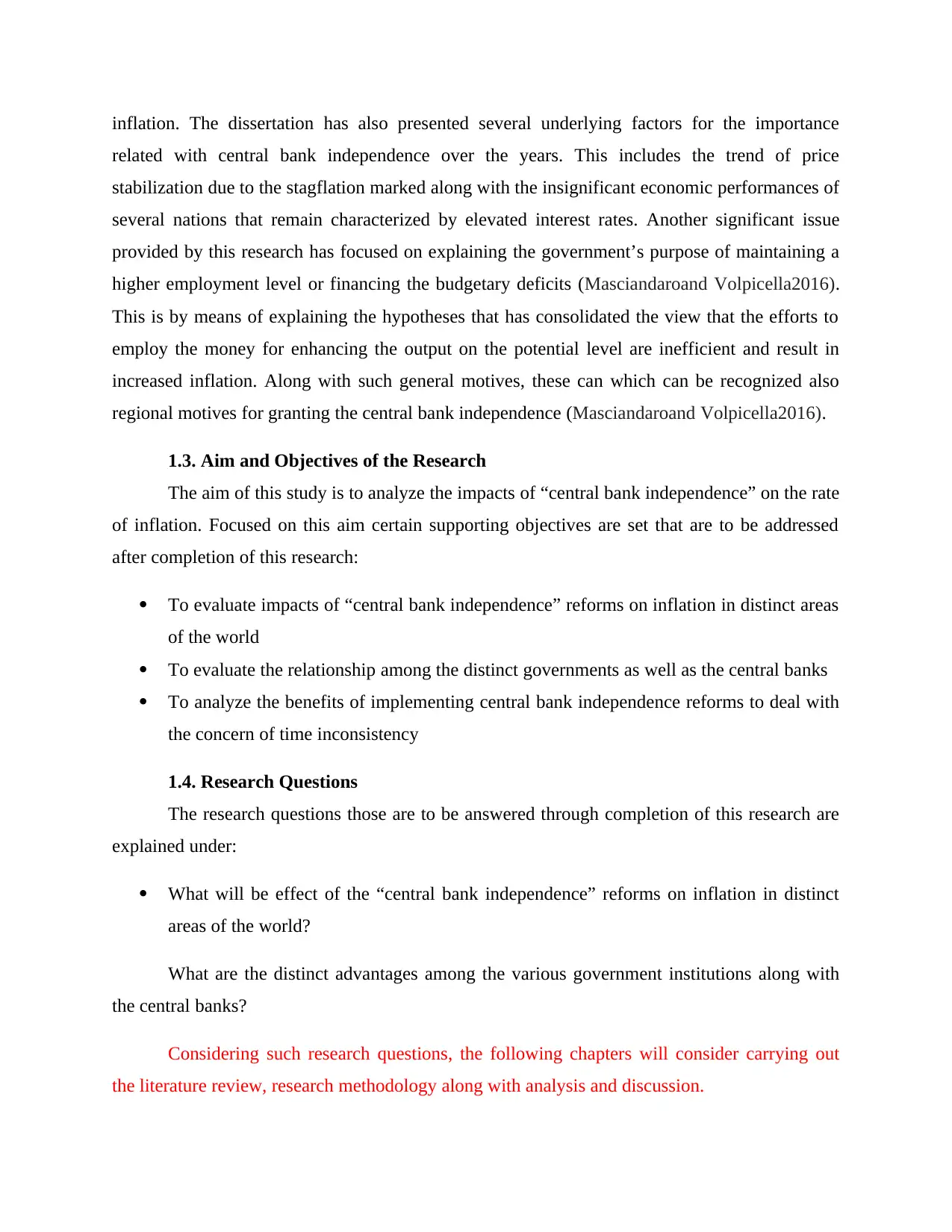
inflation. The dissertation has also presented several underlying factors for the importance
related with central bank independence over the years. This includes the trend of price
stabilization due to the stagflation marked along with the insignificant economic performances of
several nations that remain characterized by elevated interest rates. Another significant issue
provided by this research has focused on explaining the government’s purpose of maintaining a
higher employment level or financing the budgetary deficits (Masciandaroand Volpicella2016).
This is by means of explaining the hypotheses that has consolidated the view that the efforts to
employ the money for enhancing the output on the potential level are inefficient and result in
increased inflation. Along with such general motives, these can which can be recognized also
regional motives for granting the central bank independence (Masciandaroand Volpicella2016).
1.3. Aim and Objectives of the Research
The aim of this study is to analyze the impacts of “central bank independence” on the rate
of inflation. Focused on this aim certain supporting objectives are set that are to be addressed
after completion of this research:
To evaluate impacts of “central bank independence” reforms on inflation in distinct areas
of the world
To evaluate the relationship among the distinct governments as well as the central banks
To analyze the benefits of implementing central bank independence reforms to deal with
the concern of time inconsistency
1.4. Research Questions
The research questions those are to be answered through completion of this research are
explained under:
What will be effect of the “central bank independence” reforms on inflation in distinct
areas of the world?
What are the distinct advantages among the various government institutions along with
the central banks?
Considering such research questions, the following chapters will consider carrying out
the literature review, research methodology along with analysis and discussion.
related with central bank independence over the years. This includes the trend of price
stabilization due to the stagflation marked along with the insignificant economic performances of
several nations that remain characterized by elevated interest rates. Another significant issue
provided by this research has focused on explaining the government’s purpose of maintaining a
higher employment level or financing the budgetary deficits (Masciandaroand Volpicella2016).
This is by means of explaining the hypotheses that has consolidated the view that the efforts to
employ the money for enhancing the output on the potential level are inefficient and result in
increased inflation. Along with such general motives, these can which can be recognized also
regional motives for granting the central bank independence (Masciandaroand Volpicella2016).
1.3. Aim and Objectives of the Research
The aim of this study is to analyze the impacts of “central bank independence” on the rate
of inflation. Focused on this aim certain supporting objectives are set that are to be addressed
after completion of this research:
To evaluate impacts of “central bank independence” reforms on inflation in distinct areas
of the world
To evaluate the relationship among the distinct governments as well as the central banks
To analyze the benefits of implementing central bank independence reforms to deal with
the concern of time inconsistency
1.4. Research Questions
The research questions those are to be answered through completion of this research are
explained under:
What will be effect of the “central bank independence” reforms on inflation in distinct
areas of the world?
What are the distinct advantages among the various government institutions along with
the central banks?
Considering such research questions, the following chapters will consider carrying out
the literature review, research methodology along with analysis and discussion.
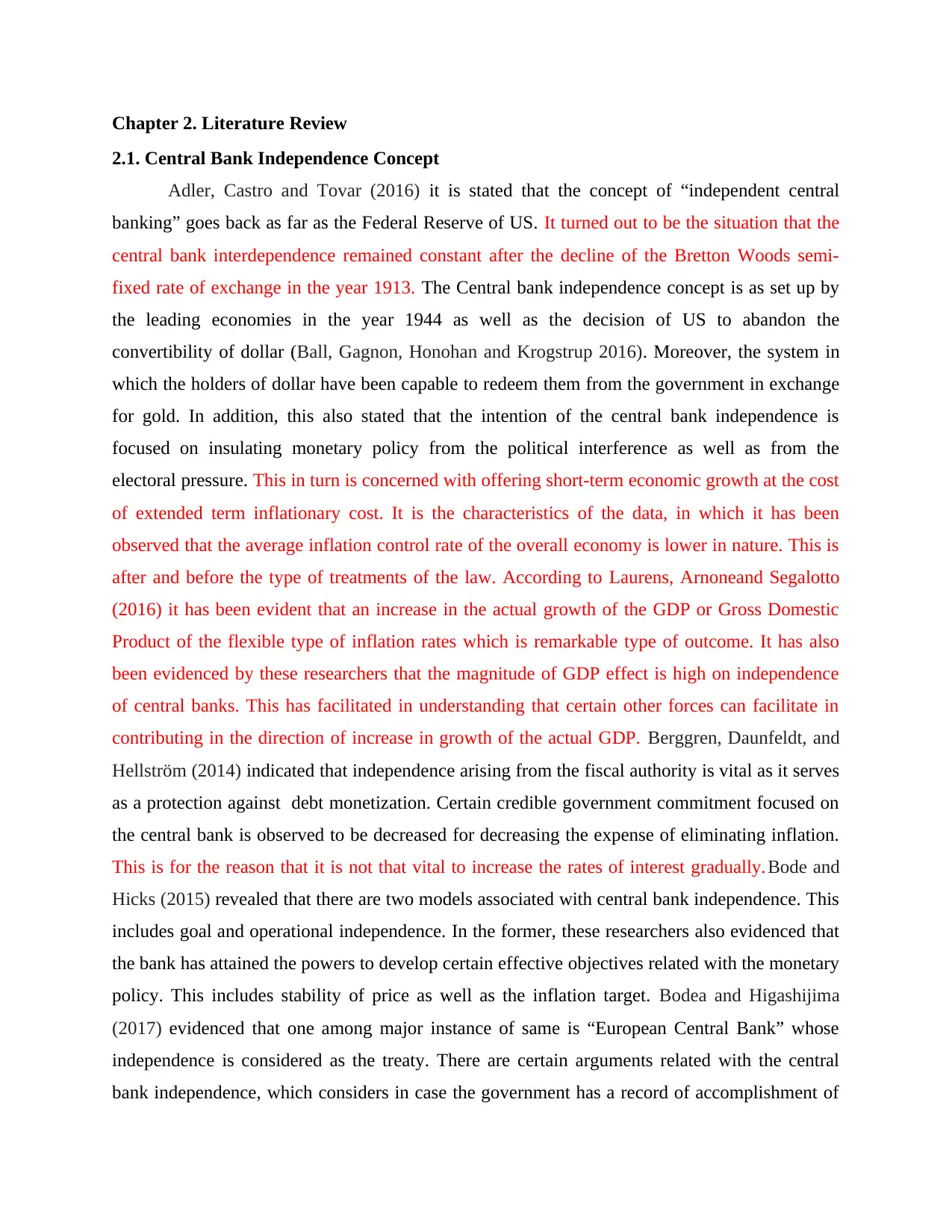
Chapter 2. Literature Review
2.1. Central Bank Independence Concept
Adler, Castro and Tovar (2016) it is stated that the concept of “independent central
banking” goes back as far as the Federal Reserve of US. It turned out to be the situation that the
central bank interdependence remained constant after the decline of the Bretton Woods semi-
fixed rate of exchange in the year 1913. The Central bank independence concept is as set up by
the leading economies in the year 1944 as well as the decision of US to abandon the
convertibility of dollar (Ball, Gagnon, Honohan and Krogstrup 2016). Moreover, the system in
which the holders of dollar have been capable to redeem them from the government in exchange
for gold. In addition, this also stated that the intention of the central bank independence is
focused on insulating monetary policy from the political interference as well as from the
electoral pressure. This in turn is concerned with offering short-term economic growth at the cost
of extended term inflationary cost. It is the characteristics of the data, in which it has been
observed that the average inflation control rate of the overall economy is lower in nature. This is
after and before the type of treatments of the law. According to Laurens, Arnoneand Segalotto
(2016) it has been evident that an increase in the actual growth of the GDP or Gross Domestic
Product of the flexible type of inflation rates which is remarkable type of outcome. It has also
been evidenced by these researchers that the magnitude of GDP effect is high on independence
of central banks. This has facilitated in understanding that certain other forces can facilitate in
contributing in the direction of increase in growth of the actual GDP. Berggren, Daunfeldt, and
Hellström (2014) indicated that independence arising from the fiscal authority is vital as it serves
as a protection against debt monetization. Certain credible government commitment focused on
the central bank is observed to be decreased for decreasing the expense of eliminating inflation.
This is for the reason that it is not that vital to increase the rates of interest gradually. Bode and
Hicks (2015) revealed that there are two models associated with central bank independence. This
includes goal and operational independence. In the former, these researchers also evidenced that
the bank has attained the powers to develop certain effective objectives related with the monetary
policy. This includes stability of price as well as the inflation target. Bodea and Higashijima
(2017) evidenced that one among major instance of same is “European Central Bank” whose
independence is considered as the treaty. There are certain arguments related with the central
bank independence, which considers in case the government has a record of accomplishment of
2.1. Central Bank Independence Concept
Adler, Castro and Tovar (2016) it is stated that the concept of “independent central
banking” goes back as far as the Federal Reserve of US. It turned out to be the situation that the
central bank interdependence remained constant after the decline of the Bretton Woods semi-
fixed rate of exchange in the year 1913. The Central bank independence concept is as set up by
the leading economies in the year 1944 as well as the decision of US to abandon the
convertibility of dollar (Ball, Gagnon, Honohan and Krogstrup 2016). Moreover, the system in
which the holders of dollar have been capable to redeem them from the government in exchange
for gold. In addition, this also stated that the intention of the central bank independence is
focused on insulating monetary policy from the political interference as well as from the
electoral pressure. This in turn is concerned with offering short-term economic growth at the cost
of extended term inflationary cost. It is the characteristics of the data, in which it has been
observed that the average inflation control rate of the overall economy is lower in nature. This is
after and before the type of treatments of the law. According to Laurens, Arnoneand Segalotto
(2016) it has been evident that an increase in the actual growth of the GDP or Gross Domestic
Product of the flexible type of inflation rates which is remarkable type of outcome. It has also
been evidenced by these researchers that the magnitude of GDP effect is high on independence
of central banks. This has facilitated in understanding that certain other forces can facilitate in
contributing in the direction of increase in growth of the actual GDP. Berggren, Daunfeldt, and
Hellström (2014) indicated that independence arising from the fiscal authority is vital as it serves
as a protection against debt monetization. Certain credible government commitment focused on
the central bank is observed to be decreased for decreasing the expense of eliminating inflation.
This is for the reason that it is not that vital to increase the rates of interest gradually. Bode and
Hicks (2015) revealed that there are two models associated with central bank independence. This
includes goal and operational independence. In the former, these researchers also evidenced that
the bank has attained the powers to develop certain effective objectives related with the monetary
policy. This includes stability of price as well as the inflation target. Bodea and Higashijima
(2017) evidenced that one among major instance of same is “European Central Bank” whose
independence is considered as the treaty. There are certain arguments related with the central
bank independence, which considers in case the government has a record of accomplishment of
⊘ This is a preview!⊘
Do you want full access?
Subscribe today to unlock all pages.

Trusted by 1+ million students worldwide
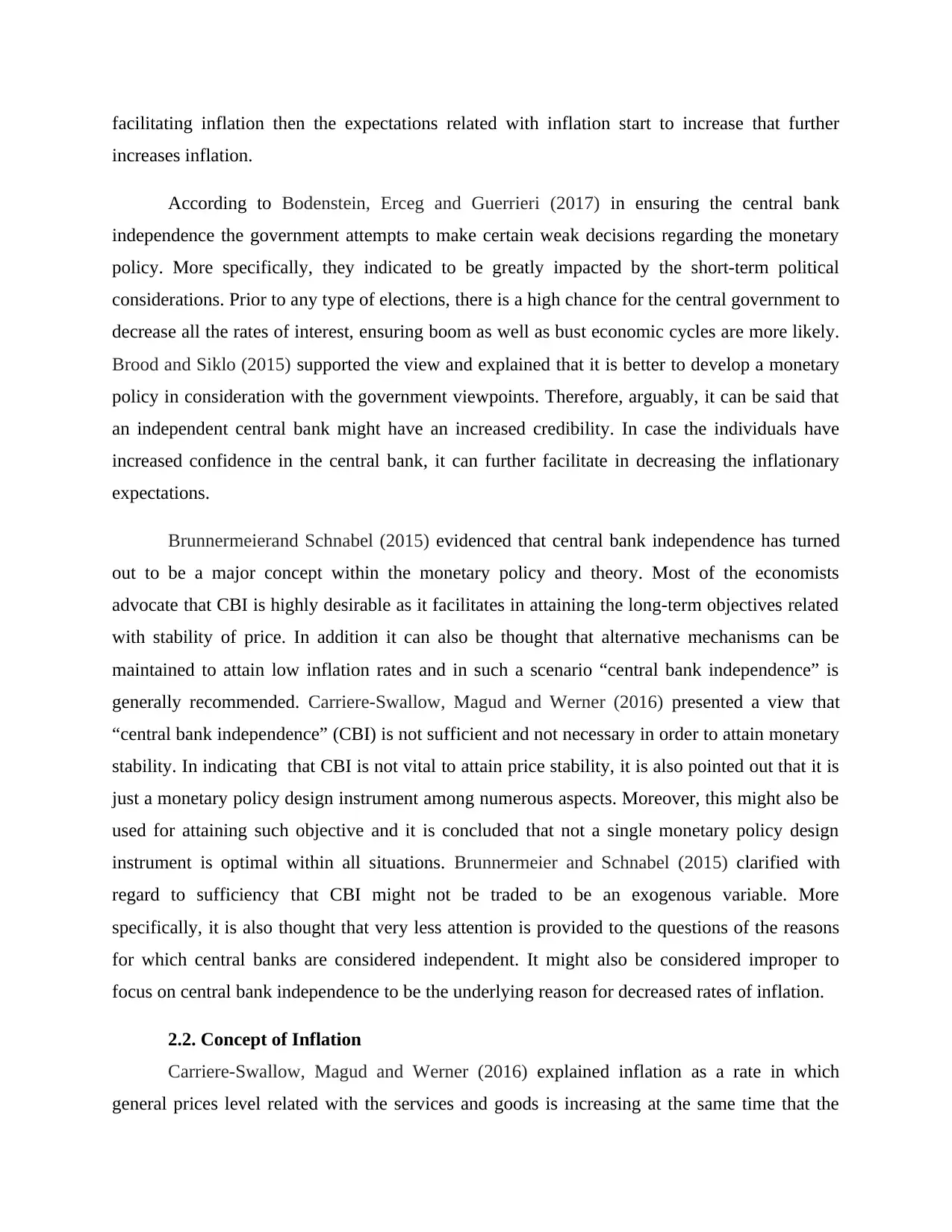
facilitating inflation then the expectations related with inflation start to increase that further
increases inflation.
According to Bodenstein, Erceg and Guerrieri (2017) in ensuring the central bank
independence the government attempts to make certain weak decisions regarding the monetary
policy. More specifically, they indicated to be greatly impacted by the short-term political
considerations. Prior to any type of elections, there is a high chance for the central government to
decrease all the rates of interest, ensuring boom as well as bust economic cycles are more likely.
Brood and Siklo (2015) supported the view and explained that it is better to develop a monetary
policy in consideration with the government viewpoints. Therefore, arguably, it can be said that
an independent central bank might have an increased credibility. In case the individuals have
increased confidence in the central bank, it can further facilitate in decreasing the inflationary
expectations.
Brunnermeierand Schnabel (2015) evidenced that central bank independence has turned
out to be a major concept within the monetary policy and theory. Most of the economists
advocate that CBI is highly desirable as it facilitates in attaining the long-term objectives related
with stability of price. In addition it can also be thought that alternative mechanisms can be
maintained to attain low inflation rates and in such a scenario “central bank independence” is
generally recommended. Carriere-Swallow, Magud and Werner (2016) presented a view that
“central bank independence” (CBI) is not sufficient and not necessary in order to attain monetary
stability. In indicating that CBI is not vital to attain price stability, it is also pointed out that it is
just a monetary policy design instrument among numerous aspects. Moreover, this might also be
used for attaining such objective and it is concluded that not a single monetary policy design
instrument is optimal within all situations. Brunnermeier and Schnabel (2015) clarified with
regard to sufficiency that CBI might not be traded to be an exogenous variable. More
specifically, it is also thought that very less attention is provided to the questions of the reasons
for which central banks are considered independent. It might also be considered improper to
focus on central bank independence to be the underlying reason for decreased rates of inflation.
2.2. Concept of Inflation
Carriere-Swallow, Magud and Werner (2016) explained inflation as a rate in which
general prices level related with the services and goods is increasing at the same time that the
increases inflation.
According to Bodenstein, Erceg and Guerrieri (2017) in ensuring the central bank
independence the government attempts to make certain weak decisions regarding the monetary
policy. More specifically, they indicated to be greatly impacted by the short-term political
considerations. Prior to any type of elections, there is a high chance for the central government to
decrease all the rates of interest, ensuring boom as well as bust economic cycles are more likely.
Brood and Siklo (2015) supported the view and explained that it is better to develop a monetary
policy in consideration with the government viewpoints. Therefore, arguably, it can be said that
an independent central bank might have an increased credibility. In case the individuals have
increased confidence in the central bank, it can further facilitate in decreasing the inflationary
expectations.
Brunnermeierand Schnabel (2015) evidenced that central bank independence has turned
out to be a major concept within the monetary policy and theory. Most of the economists
advocate that CBI is highly desirable as it facilitates in attaining the long-term objectives related
with stability of price. In addition it can also be thought that alternative mechanisms can be
maintained to attain low inflation rates and in such a scenario “central bank independence” is
generally recommended. Carriere-Swallow, Magud and Werner (2016) presented a view that
“central bank independence” (CBI) is not sufficient and not necessary in order to attain monetary
stability. In indicating that CBI is not vital to attain price stability, it is also pointed out that it is
just a monetary policy design instrument among numerous aspects. Moreover, this might also be
used for attaining such objective and it is concluded that not a single monetary policy design
instrument is optimal within all situations. Brunnermeier and Schnabel (2015) clarified with
regard to sufficiency that CBI might not be traded to be an exogenous variable. More
specifically, it is also thought that very less attention is provided to the questions of the reasons
for which central banks are considered independent. It might also be considered improper to
focus on central bank independence to be the underlying reason for decreased rates of inflation.
2.2. Concept of Inflation
Carriere-Swallow, Magud and Werner (2016) explained inflation as a rate in which
general prices level related with the services and goods is increasing at the same time that the
Paraphrase This Document
Need a fresh take? Get an instant paraphrase of this document with our AI Paraphraser
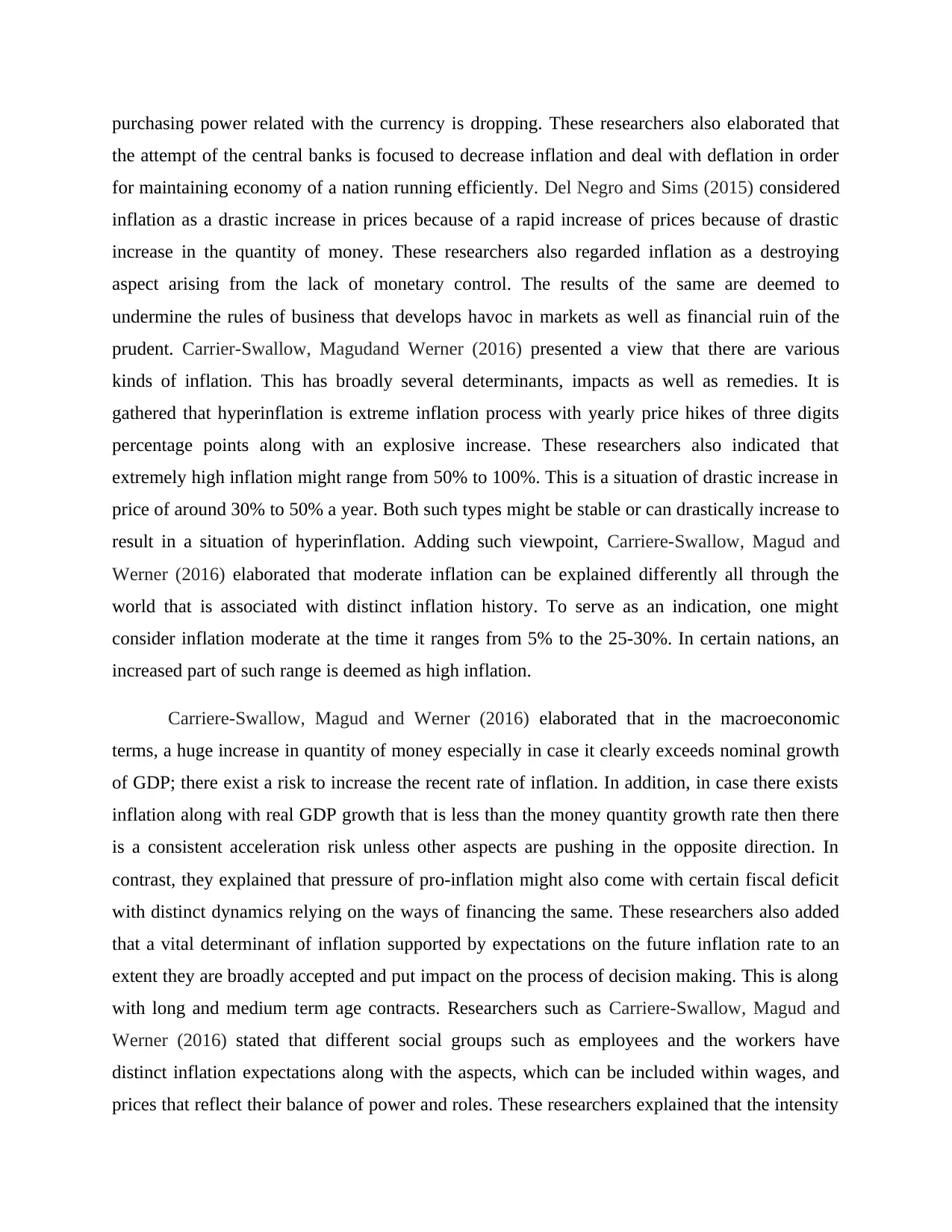
purchasing power related with the currency is dropping. These researchers also elaborated that
the attempt of the central banks is focused to decrease inflation and deal with deflation in order
for maintaining economy of a nation running efficiently. Del Negro and Sims (2015) considered
inflation as a drastic increase in prices because of a rapid increase of prices because of drastic
increase in the quantity of money. These researchers also regarded inflation as a destroying
aspect arising from the lack of monetary control. The results of the same are deemed to
undermine the rules of business that develops havoc in markets as well as financial ruin of the
prudent. Carrier-Swallow, Magudand Werner (2016) presented a view that there are various
kinds of inflation. This has broadly several determinants, impacts as well as remedies. It is
gathered that hyperinflation is extreme inflation process with yearly price hikes of three digits
percentage points along with an explosive increase. These researchers also indicated that
extremely high inflation might range from 50% to 100%. This is a situation of drastic increase in
price of around 30% to 50% a year. Both such types might be stable or can drastically increase to
result in a situation of hyperinflation. Adding such viewpoint, Carriere-Swallow, Magud and
Werner (2016) elaborated that moderate inflation can be explained differently all through the
world that is associated with distinct inflation history. To serve as an indication, one might
consider inflation moderate at the time it ranges from 5% to the 25-30%. In certain nations, an
increased part of such range is deemed as high inflation.
Carriere-Swallow, Magud and Werner (2016) elaborated that in the macroeconomic
terms, a huge increase in quantity of money especially in case it clearly exceeds nominal growth
of GDP; there exist a risk to increase the recent rate of inflation. In addition, in case there exists
inflation along with real GDP growth that is less than the money quantity growth rate then there
is a consistent acceleration risk unless other aspects are pushing in the opposite direction. In
contrast, they explained that pressure of pro-inflation might also come with certain fiscal deficit
with distinct dynamics relying on the ways of financing the same. These researchers also added
that a vital determinant of inflation supported by expectations on the future inflation rate to an
extent they are broadly accepted and put impact on the process of decision making. This is along
with long and medium term age contracts. Researchers such as Carriere-Swallow, Magud and
Werner (2016) stated that different social groups such as employees and the workers have
distinct inflation expectations along with the aspects, which can be included within wages, and
prices that reflect their balance of power and roles. These researchers explained that the intensity
the attempt of the central banks is focused to decrease inflation and deal with deflation in order
for maintaining economy of a nation running efficiently. Del Negro and Sims (2015) considered
inflation as a drastic increase in prices because of a rapid increase of prices because of drastic
increase in the quantity of money. These researchers also regarded inflation as a destroying
aspect arising from the lack of monetary control. The results of the same are deemed to
undermine the rules of business that develops havoc in markets as well as financial ruin of the
prudent. Carrier-Swallow, Magudand Werner (2016) presented a view that there are various
kinds of inflation. This has broadly several determinants, impacts as well as remedies. It is
gathered that hyperinflation is extreme inflation process with yearly price hikes of three digits
percentage points along with an explosive increase. These researchers also indicated that
extremely high inflation might range from 50% to 100%. This is a situation of drastic increase in
price of around 30% to 50% a year. Both such types might be stable or can drastically increase to
result in a situation of hyperinflation. Adding such viewpoint, Carriere-Swallow, Magud and
Werner (2016) elaborated that moderate inflation can be explained differently all through the
world that is associated with distinct inflation history. To serve as an indication, one might
consider inflation moderate at the time it ranges from 5% to the 25-30%. In certain nations, an
increased part of such range is deemed as high inflation.
Carriere-Swallow, Magud and Werner (2016) elaborated that in the macroeconomic
terms, a huge increase in quantity of money especially in case it clearly exceeds nominal growth
of GDP; there exist a risk to increase the recent rate of inflation. In addition, in case there exists
inflation along with real GDP growth that is less than the money quantity growth rate then there
is a consistent acceleration risk unless other aspects are pushing in the opposite direction. In
contrast, they explained that pressure of pro-inflation might also come with certain fiscal deficit
with distinct dynamics relying on the ways of financing the same. These researchers also added
that a vital determinant of inflation supported by expectations on the future inflation rate to an
extent they are broadly accepted and put impact on the process of decision making. This is along
with long and medium term age contracts. Researchers such as Carriere-Swallow, Magud and
Werner (2016) stated that different social groups such as employees and the workers have
distinct inflation expectations along with the aspects, which can be included within wages, and
prices that reflect their balance of power and roles. These researchers explained that the intensity
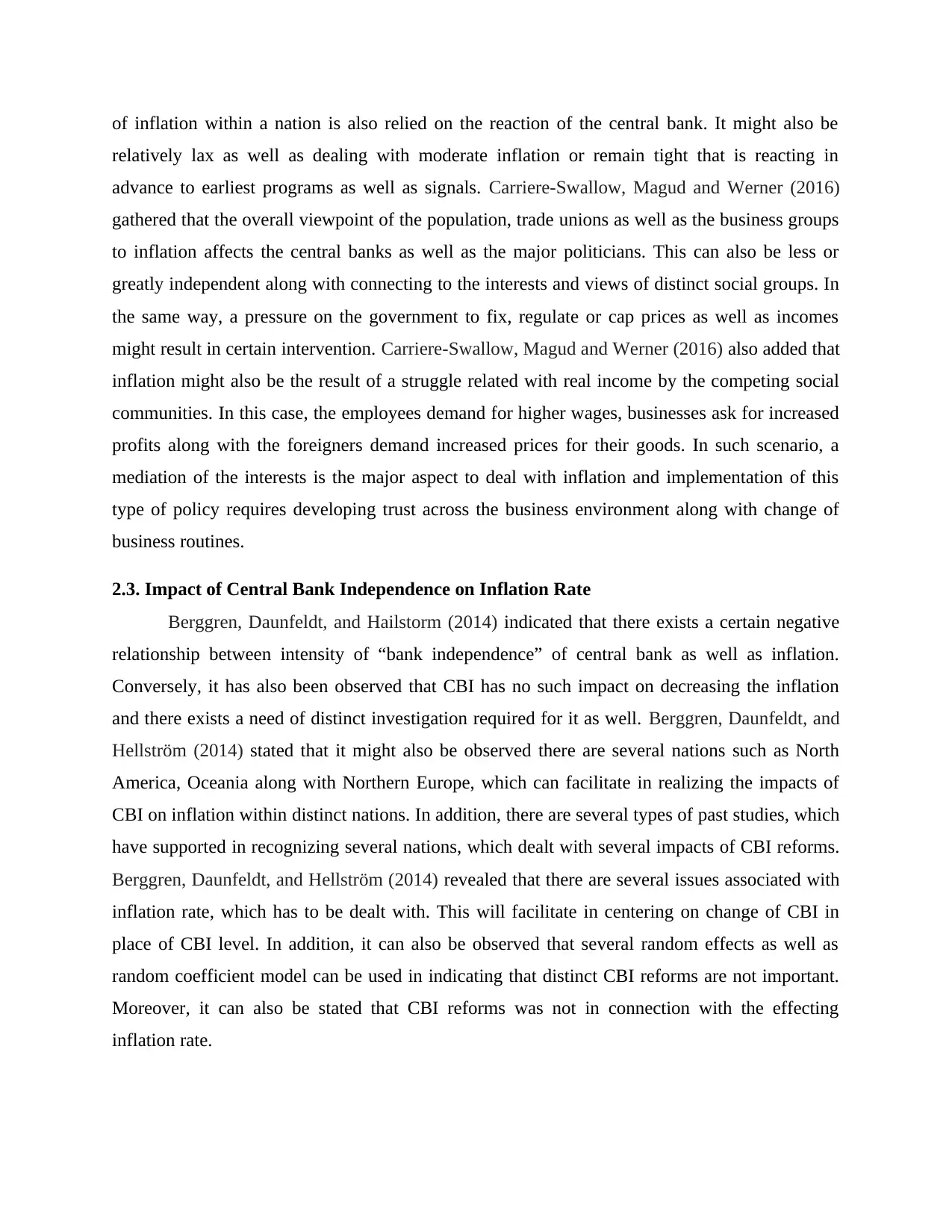
of inflation within a nation is also relied on the reaction of the central bank. It might also be
relatively lax as well as dealing with moderate inflation or remain tight that is reacting in
advance to earliest programs as well as signals. Carriere-Swallow, Magud and Werner (2016)
gathered that the overall viewpoint of the population, trade unions as well as the business groups
to inflation affects the central banks as well as the major politicians. This can also be less or
greatly independent along with connecting to the interests and views of distinct social groups. In
the same way, a pressure on the government to fix, regulate or cap prices as well as incomes
might result in certain intervention. Carriere-Swallow, Magud and Werner (2016) also added that
inflation might also be the result of a struggle related with real income by the competing social
communities. In this case, the employees demand for higher wages, businesses ask for increased
profits along with the foreigners demand increased prices for their goods. In such scenario, a
mediation of the interests is the major aspect to deal with inflation and implementation of this
type of policy requires developing trust across the business environment along with change of
business routines.
2.3. Impact of Central Bank Independence on Inflation Rate
Berggren, Daunfeldt, and Hailstorm (2014) indicated that there exists a certain negative
relationship between intensity of “bank independence” of central bank as well as inflation.
Conversely, it has also been observed that CBI has no such impact on decreasing the inflation
and there exists a need of distinct investigation required for it as well. Berggren, Daunfeldt, and
Hellström (2014) stated that it might also be observed there are several nations such as North
America, Oceania along with Northern Europe, which can facilitate in realizing the impacts of
CBI on inflation within distinct nations. In addition, there are several types of past studies, which
have supported in recognizing several nations, which dealt with several impacts of CBI reforms.
Berggren, Daunfeldt, and Hellström (2014) revealed that there are several issues associated with
inflation rate, which has to be dealt with. This will facilitate in centering on change of CBI in
place of CBI level. In addition, it can also be observed that several random effects as well as
random coefficient model can be used in indicating that distinct CBI reforms are not important.
Moreover, it can also be stated that CBI reforms was not in connection with the effecting
inflation rate.
relatively lax as well as dealing with moderate inflation or remain tight that is reacting in
advance to earliest programs as well as signals. Carriere-Swallow, Magud and Werner (2016)
gathered that the overall viewpoint of the population, trade unions as well as the business groups
to inflation affects the central banks as well as the major politicians. This can also be less or
greatly independent along with connecting to the interests and views of distinct social groups. In
the same way, a pressure on the government to fix, regulate or cap prices as well as incomes
might result in certain intervention. Carriere-Swallow, Magud and Werner (2016) also added that
inflation might also be the result of a struggle related with real income by the competing social
communities. In this case, the employees demand for higher wages, businesses ask for increased
profits along with the foreigners demand increased prices for their goods. In such scenario, a
mediation of the interests is the major aspect to deal with inflation and implementation of this
type of policy requires developing trust across the business environment along with change of
business routines.
2.3. Impact of Central Bank Independence on Inflation Rate
Berggren, Daunfeldt, and Hailstorm (2014) indicated that there exists a certain negative
relationship between intensity of “bank independence” of central bank as well as inflation.
Conversely, it has also been observed that CBI has no such impact on decreasing the inflation
and there exists a need of distinct investigation required for it as well. Berggren, Daunfeldt, and
Hellström (2014) stated that it might also be observed there are several nations such as North
America, Oceania along with Northern Europe, which can facilitate in realizing the impacts of
CBI on inflation within distinct nations. In addition, there are several types of past studies, which
have supported in recognizing several nations, which dealt with several impacts of CBI reforms.
Berggren, Daunfeldt, and Hellström (2014) revealed that there are several issues associated with
inflation rate, which has to be dealt with. This will facilitate in centering on change of CBI in
place of CBI level. In addition, it can also be observed that several random effects as well as
random coefficient model can be used in indicating that distinct CBI reforms are not important.
Moreover, it can also be stated that CBI reforms was not in connection with the effecting
inflation rate.
⊘ This is a preview!⊘
Do you want full access?
Subscribe today to unlock all pages.

Trusted by 1+ million students worldwide
1 out of 118
Related Documents
Your All-in-One AI-Powered Toolkit for Academic Success.
+13062052269
info@desklib.com
Available 24*7 on WhatsApp / Email
![[object Object]](/_next/static/media/star-bottom.7253800d.svg)
Unlock your academic potential
Copyright © 2020–2025 A2Z Services. All Rights Reserved. Developed and managed by ZUCOL.




